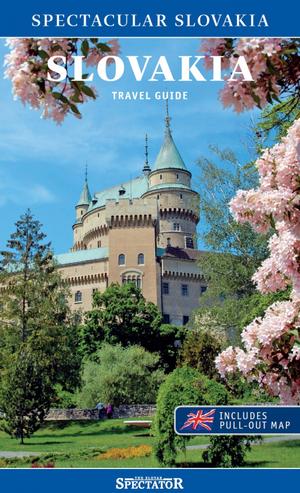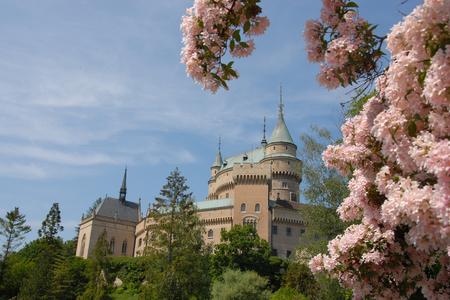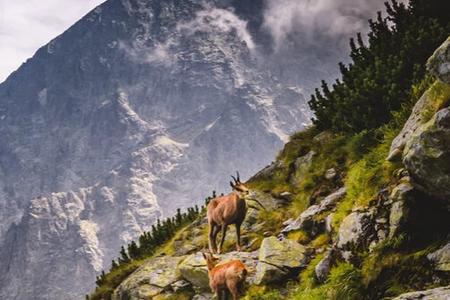This is an article from archive of travel guides Spectacular Slovakia. We decided to make this gem available for our readers, making only necessary adjustments. Some of writer’s observations from year 2004 has changed but much still hold true. For up-to-date information and feature stories, take a look at the latest edition of our Spectacular Slovakia guide.
The 1998 film The Blair Witch Project tells the story of three filmmakers who go to the woods to investigate a legend, get disoriented, lost and finally killed. It's a spooky movie, especially if you know the feeling of being astray at night in a forest.
 www.spectacularslovakia.sk
www.spectacularslovakia.sk
Slovak friends of mine who saw it thought it was dumb. "They cross a river three times," they said.
"So?"
"Every grade-schooler learns, when you're lost in the woods, you follow the nearest river. A river always leads somewhere."
Since I lacked such practical knowledge, I asked a friend, Daniela (Danka for short) Danihelová, 29, to take me hiking in the Malá Fatra mountains.
Danka grew up in Bratislava, but like many Slovaks, spent her summers in camps in the mountains, where she learned to read trail maps, build fires, follow rivers when lost, and so on. As an adult, she was a veteran of mountain hikes in Romania, Bulgaria and the Himalayas.
Danka e-mailed me a few days before our trip telling me to bring a sleeping bag, sleeping mat, rain poncho, and at least two liters of water. I replied that I didn't have a mat, poncho or sleeping bag, but she never got the e-mail. So she was surprised at the train station to find that I lacked those items. And then she noticed that I had a rubber water bladder in my backpack with a tube snaking out over my shoulder that allowed me to suck in water without having to stop and dig out a bottle.
"You have that," she said, "but you don't have a sleeping bag?"
The hike starts in Strečno
My backpack was heavy, anyhow. I had a laptop, five books, a Slovak-English dictionary, pens, notepads, a mini-disk player, and clothes for fair and foul weather. Altogether, it weighed 20 kilograms.

My shoulders were sore and my legs were rubbery by the time I got to the Bratislava train station. Danka and I took a train to Žilina (where I bought a sleeping bag), and from there took a bus to Strečno, a small town on the River Váh surrounded by fat green mountains. In a gap between the mountains, high on a cliff over the Váh, stood Strečno's chalk-white Castle. Danka took out a map and plotted a course. She had a red handkerchief on her head, and a nature-lover's gleam in her eye.
We found a trail that crossed the Váh, passed a row of houses, led into a forest of pine trees, and skirted a few hills before shooting up the side of a mountain. Before long, I was sweating and puffing like the fat kid on the first day of football practice. Meanwhile, Danka looked like she could run behind a tree, change into a dress and go to the prom. Her thin, curvy body looked incapable of carrying a heavy backpack up a mountain, but it was just an illusion. Her legs were as hard as tree trunks, even though they didn't look like tree trunks.
"Are you ok?" she said, staring at me with big eyes.
"I'll make it," I said.
"You wanted a tough hike."
Three hellish hours later, we heard a dog bark, and then the outlines of a wooden cottage appeared in the purple darkness. "Thank god," I said. I peeled the backpack off my shoulders and sat down on a stump.
A night outside a mountain chalet
Mountains in Slovakia are dotted with chaty (chalets). They are clearly marked on maps and with a little planning, you can basically hike wherever you want and have a place to sleep at the end of the day. A bed - usually a bunk - costs a few hundred crowns.
Most cottages are owned by the state, and you can generally sleep outside of them for free (camping is otherwise illegal in national parks).
Our Spectacular Slovakia travel guides are available in our online shop.
Danka wanted to sleep outside. I said ok, even though I didn't have a mat, and my sleeping bag (the cheapest one at the Žilina Tesco) wasn't quite warm enough for the single-digit (Celsius) temperatures.
We climbed into our sleeping bags. Thousands of stars flickered above us. I pointed at the Big Dipper.
"Why do Slovaks call it the Big Cart [Veľký voz] '?" I said. "The handle's too long. How could you push a cart like that?"
"You don't push it," Danka said. "You pull it. Over your shoulder."
Danka taught me that passes between peaks were called "sedlo", or saddles, and that a string of peaks was a "hrebeň", or comb - as though the hand of god had come down and parted the land with a giant comb.
To the Veľký Kriváň peak
The next day, Danka rose with the sun, filled our water bottles, sliced some bread for me and plotted a course for the day.
"Let's climb Veľký Kriváň," she said. "It's the highest peak. If we make good time, we can hike two more peaks before dark."
She looked at me and frowned. I was still in my sleeping bag. "If you're tired, there's a chair lift at Kriváň that can take us to a cabin."

Just getting to Kriváň, about seven hours away, seemed like too much. But day two was easier. Somehow, my body got used to the pack. We moved up and down the "sedlá" without too many problems. The trails were easy to follow, and it was sunny but cool.
We entered a forest of beech trees - silvery trunks and bright green leaves. Higher up, the trees petered out, and all that remained was grass, rocks and scrubby pine bushes.
As we hiked, Danka shoved flowers under my nose and wild berries into my mouth. She found water when we needed it, and taught me how to make a hat out of something that looked like a lily pad. All in all, she was exceptionally mountain worthy.
I thought of a story I heard once from a Slovak man, it was about his foreign girlfriend and their different feel for the outdoors. He had met her abroad, and after he returned home, she came to visit. They took a train to a little town by a lake. They spent the afternoon swimming, and by the time they made it to a hotel, all the rooms were taken.
"Is it ok if we sleep in a tent?" he said. He had one in his backpack.
"Ok," she said.
But when she saw him pulling the tent out, she burst into tears.
Spectacular Slovakia travel guides
A helping hand in the heart of Europe thanks to the Slovakia travel guide with more than 1,000 photos and hundred of tourist spots.
Detailed travel guide to the Tatras introduces you to the whole region around the Tatra mountains, including attractions on the Polish side.
Lost in Bratislava? Impossible with our City Guide!
See some selected travel articles, podcasts, traveller's needs as well as other guides dedicated to Nitra, Trenčín Region, Trnava Region and Žilina Region.

 Skalnatá Cabin, High Tatras (source: Ján Svrček)
Skalnatá Cabin, High Tatras (source: Ján Svrček)
 Špania dolina (Central Slovakia) (source: Dušan Beňo)
Špania dolina (Central Slovakia) (source: Dušan Beňo)